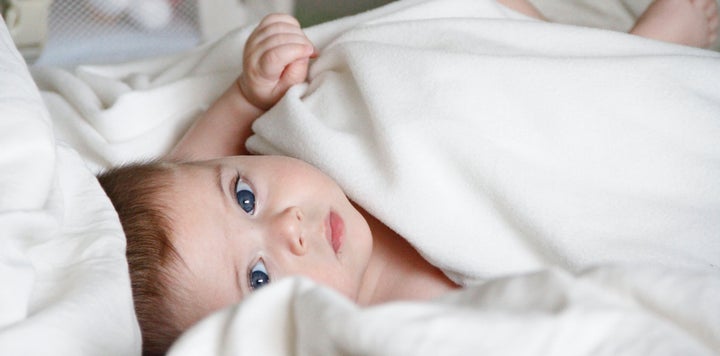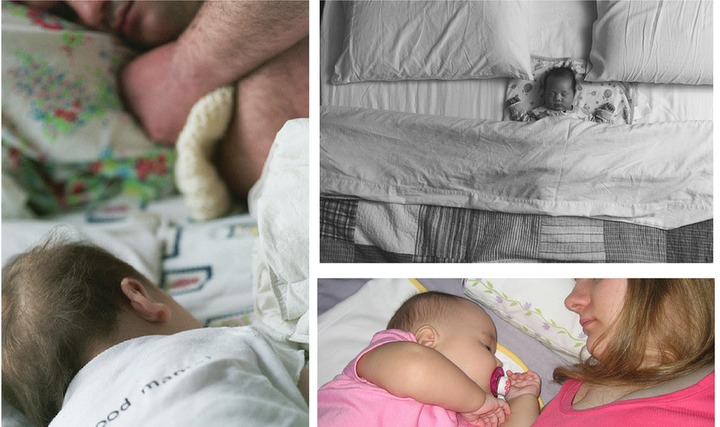
In recent years, co-sleeping, or more specifically, bed-sharing has made a large resurgence in new parents looking for ways to be close to their child, in terms of bonding, physical contact, and ease of care. While in terms of attentive parenting, it is encouraging to see more and more families strive to develop close bonds with their infants, it is also quite troubling at the amount of misconceptions that are floating around about bed-sharing. From a variety of well-meaning sources, such as KellyMom, LaLeche League International, Dr. Sears, and anthropologist James McKenna of the Mother-Baby Behavioral Sleep Laboratory, there is an abundance of false platitudes that bed-sharing with your baby is "perfectly fine if you do it safely".
Let's be honest here.
There is no way to make bed sharing safe enough without putting your baby at a real risk of suffering a preventable sleep death in your own bed.
Bed-sharing with your child is considered to be the greatest risk factor for sleep-related sleep deaths. In fact, 69% of all sleep-related infant deaths are associated with bedsharing. Additionally, it is estimated that 90% of the infant sleep deaths documented would not have occurred, had the child not been bed-sharing with their caregiver.
This is true, EVEN if you are "safely" bed-sharing. Even if you and your partner don't smoke or drink, or don’t have extra pillows on the bed, remove the bedding completely, or put your baby in a co-sleeper that sits in between the two of you so that you can't roll onto your child. Just simply having your baby sleep directly, or indirectly via a co-sleeper, on your mattress increases the risk of your child dying from an infant sleep-related death
Bed-sharing does not decrease the chances of your child dying from SIDS (Sudden Infant Death Syndrome) but it does increase your child's chances of dying from suffocation, entrapment, and positional asphyxiation, all related causes of SIDS.
The American Academy of Pediatric (AAP), a group of over 66,000 pediatricians, pediatric medical sub-specialists and pediatric surgical specialists, have been instrumental in educating the health care industry, early childhood educators, and parents on the findings of sleep risks involving children and how to implement safe sleep. In 1992, they promoted the practice of the safe sleep ABCs (Alone on their Back in the Crib), in efforts to reduce the occurrences of preventable infant sleep deaths. By 2000, the number of infant sleep deaths had dropped 53%.
While the occurrence of true SIDS cases (deaths that are determined to be unexplained or caused by intrinsic risk factors, such as low birth weight) have continued to decrease, the AAP was alarmed to see that since the early 2000's, the number of preventable infant sleep deaths by cause of suffocation, asphyxia, and entrapment have increased. Despite knowing that following the sleep ABCs is best practice regarding infant sleep, nearly 45% of American parents report that they have bed-shared with their child at least once in the past two weeks.
In recent years, various professionals and organizations have tried to manipulate studies and research to show that co-sleeping can be done safely in the interest of protecting the breastfeeding relationship and the mother-child bond. In addition to switching around the terminology of co-sleeping and bed-sharing, they commonly cite faulty studies, studies that are not peer-reviewed, and out-dated research practices to try to convince parents desperate for sleep, successful breastfeeding relationships, and strong bonds with their child, that bed-sharing is perfectly safe if you do it "right". It is proven, and the AAP has the data to back it up, that bed-sharing can never be done safely.
Despite best intentions, the biggest risk for bed sharing can be you.
You see these sweet, beautiful pictures of parents sleeping with their child, and everything looks so peaceful and perfect. Social media, such as Instagram or Facebook, contain countless of images, and it's really hard to not want the same experience with your own child. But the harsh reality is, in every one of those pictures, the child is at risk of dying from infant sleep death.

Examples of unsafe sleep practices
Sleeping in the prone (on the stomach) position on the adult bed, unsafe bedding and pillows, and being in extremely close quarters all contribute to the dangers and increased risk of bed sharing. In every photo op, the child is at risk of being suffocated by the bedding and/or caregiver, suffering from positional asphyxiation, and/or entrapment. As sweet as the moment appears to be, the risk and dangers are very high.
What's even more frustrating about unsafe practices when it comes to babies and sleep, is that many parents never intend to bed-share but only do so out of desperation. Whether they are desperate for sleep, worried about keeping their milk supply up, or simply are afraid that their bond with their child won't be as strong, bed-sharing becomes an act of "necessity". The truth of the matter is that following the sleep ABCs does not affect the breastfeeding relationship or negatively affect the parental bond with the baby. It also does not affect the baby's ability to sleep well, even in the very beginning. Sleep can feel like a different story, as the first eight to twelve weeks of a newborn's life can seem chaotic when it comes to sleep. Newborns are extremely sensitive to wake times, require constant feeds, and excel when given hands-on care by their caregivers. To a new parent, this is a daunting task. Here are five tips to help you get through the first few months without sacrificing safe sleep practices.
- Implement the ABCs on Day 1 - When your baby falls asleep, move them to a safe sleep surface, such as the crib/bassinet/pack n play, and place them on their backs. Make this non-negotiable. Ensuring that your baby gets practice on sleeping safely on their own in a safe environment will create healthy sleep skills from the start.
- Swaddle Up - Babies spend the last trimester cocooned in within the womb. Being born means that being snuggled up in a tight quarters is no longer a reality, and that can be disconcerting. Swaddling your baby for the first 8 weeks of their life can help them feel comforted and can aid in helping them sleep better.
- Keeping it Warm - Part of enjoying your newborn is snuggling with them and reveling in the miracle of it all. For your baby, the warmth and your scent is what soothes them and helps them feel secure. When you know naptime or bedtime is approaching, laying a heat pack on the mattress of the sleep surface can help with the transfer from your arms and body heat to their bed. Lay the heat pack for a few minutes to warm the surface and then remove it shortly before you lay your newborn down.
- Sweet Smells - Long before your baby recognizes you by sight, they recognize you by smell. "Wearing" or laying with the mattress sheet or swaddle prior to nap and bed time can help your smell travel with the baby when they get transitioned into their bed.
- Tag Team - Perhaps the most important tip to implement - tag team with your partner or baby's other caregiver(s) throughout the day and at night. Ensuring that you get some rest and sleep during the childbirth recovery period is just as important as making sure the baby gets to eat and rest. Make a plan with your partner that you each take shifts tending to the baby. If you are breastfeeding, make it clear that you will breastfeed as the baby needs to eat, but then your partner needs to resume care-giving duties if it's on "their" time to ensure that you get your rest.
It has been proven consistently that bed-sharing is inherently dangerous and risky for infants, as they are powerless in being able to control their own environment. If a blanket, pillow, or bed-mate were to fall over your face, you have the ability to remove it, even in sleep. An infant does not. When you are in deep sleep, or experiencing sleep deprivation, your body and response levels are NOT predictable. In addition to your bed being a risky sleep surface for your baby, you are a risk factor to your child if you decide to bed-share. What could be justified as an act of convenience, security, or an opportunity to bond, could lead to fatal results and life-altering heartache. By following the evidence and commit to practicing the ABC of safe sleep, you significantly reduce your child's chances of suffering from an infant sleep-related death.
